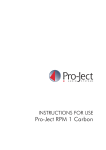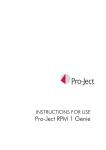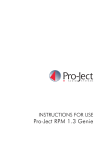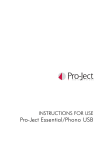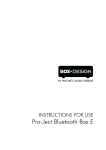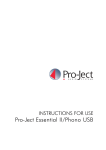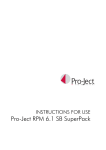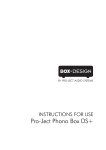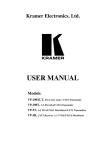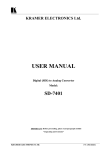Download Pro-Ject RPM 3 Carbon User Guide
Transcript
INSTRUCTIONS FOR USE Pro-Ject RPM 3 Carbon 2 © Pro-Ject Audio Systems · Pro-Ject RPM 3 Carbon / Ortofon 2M SILVER · Revision 2015.01.29 Controls, features and connections 1/11 Power switch, motor unit with stepped drive pulley 2 Drive belt * 3 Platter 4 Tonearm counterweight * 5 Tonearm lift lever 6/16 Tonearm rest and removable transport lock 7 Tonearm tube 8 Power supply socket 9 Phono output sockets and earth connection 10 Magnetic anti-skating mechanism 12 Magnetic anti-skating scale 13 Magnetic anti-skating adjustment mechanism 14 Headshell with finger lift Connection cable (not shown)* Power supply (not shown) * Stylus pressure gauge - white plastic instrument with mN scale (not shown) * Hexagonal key (not shown) * © Pro-Ject Audio Systems · Pro-Ject RPM 3 Carbon / Ortofon 2M SILVER · Revision 2015.01.29 3 Pro-Ject RPM 3 Carbon Dear music lover, thank you for purchasing a Pro-Ject Audio Systems record player. In order to achieve maximum performance and reliability with this record player you should study these instructions for use carefully. ! Warning of a hazard for the user, the unit or possible misuse. Important notice. The record player is supplied without cartridge or with a factory fitted and adjusted cartridge Ortofon 2M SILVER. ** The following instructions for adjusting the cartridge are provided in case the cartridge is mounted (turntable was supplied without cartridge) or is replaced by a different model at a later date . During assembly and adjustment of the deck small parts could be lost if not carefully placed in a suitable receptacle. Before starting assembly make yourself acquainted with the parts listed above and correspondingly numbered in the technical drawings above. Separately packed items are marked with an asterisk *. Set-up Make sure the surface you wish to use the turntable on is level (use a spirit level) before placing the turntable on it. After putting the motor unit in place, fit the drive belt (2) around the platter (3) and the smaller diameter part of the motor pulley (1). Avoid getting sweat or grease on the belt as these will deteriorate the performance and reduce the belt's lifespan. Use absorbent kitchen paper to remove any oil or grease from the outer edge of the platter and the belt. Remove the transport lock (16) from the tonearm. Store it in the original packaging so they are available for any future transportation. Cartridge downforce adjustment The counterweight (4) supplied is suitable for cartridges weighing between 5 - 12g (counterweight no. 82). Adjust the downforce prior to setting the anti-skating force. Place counterweight (4) halfway along the counterweight support rod at rear of arm, being sure to have the securing screw uppermost. Remove the felt mat. With the power off, and the platter static, place the stylus pressure gauge onto the platter. To set the recommended 18mN downforce (1mN = 0,1g / 0,1 Pond), place the tip of the stylus exactly in-between the two points marked 15mN and 20mN. If the stylus gauge becomes level, then the correct pressure has been achieved. However if the there is insufficient or excessive pressure the gauge will either not move or tilt down. To adjust the amount of pressure, carefully move the counterweight (4) along the support rod, until the stylus pressure is sufficient to raise the pressure gauge to the level position. Moving the counterweight (4) away from the cartridge will reduce pressure and towards will increase pressure. Finally secure the counterweight (4) using hexagonal key provided. Please note: It is advised to remove stylus tip from gauge whilst making adjustments to avoid damage to stylus. 4 © Pro-Ject Audio Systems · Pro-Ject RPM 3 Carbon / Ortofon 2M SILVER · Revision 2015.01.29 Adjusting the vertical tracking angle (vta) ** Put a record on the platter. When the needle is lowered into the record groove and the tonearm is not resting on the lift arm, the tube of the tonearm should be parallel to the surface of the record. If it is not loosen both screws in the tonearm base just enough to allow vertical movement of the arm pillar without force and slide the arm up or down until it is parallel. Carefully retighten the screws without applying excessive force (which would deform the arm pillar) – finger tight is quite sufficient. Adjusting the azimuth ** The cartridge needle must be vertical in the record groove in order to trace the groove wall modulations correctly. A small screw at the bearing end of the arm allows incorrect azimuth to be corrected if your needle is not mounted exactly perpendicular to the cartridge body (which is often the case). Slacken off the screw just enough to be able to revolve the arm tube without applying force. Please note: do not remove the screw completely! With the aid of a good magnifying glass adjust the needle until it is vertical in the groove (i.e. perpendicular to the record's surface). Ideally this should correspond to the top surface of the cartridge body being parallel to the record surface. When you are satisfied that the needle is vertical retighten the screw carefully. Under no circumstances should the arm tube be adjusted with the needle still in the record groove! Irreparable damage may be caused to the cantilever suspension! The arm must be lifted to make each adjustment and lowered afterwards to check it. Anti-skating force adjustment The anti-skating force must be adjusted corresponding to the downforce. The anti-skating mechanism is calibrated from 0 to 5g. The anti-skating force should correspond with the downforce. Three examples of magnetic anti-skating mechanism: a) Downforce – 1,5g; Anti-skating force 1,5g b) Downforce – 1,7g; Anti-skating force 1,7g c) Downforce – 2,3g; Anti-skating force 2,3g © Pro-Ject Audio Systems · Pro-Ject RPM 3 Carbon / Ortofon 2M SILVER · Revision 2015.01.29 5 Connection to the amplifier The record player has gold plated female RCA phono sockets (9) for connection to the amplifier using the supplied interconnect cables. Use the Phono input (sometimes labelled gram, disc or RIAA) on your amplifier. Make sure that the phono input offers correct matching and amplification for the type of cartridge used. Line inputs (such as CD, Tuner, Tape or Video) are not suitable. Take care to connect the left and right channels correctly. The right channel is usually marked red, the left channel black or white. Check the manual supplied with your amplifier for relevant information. An earthing wire may be connected to the screw terminal between the sockets if you encounter hum problems when using the record player. If your amplifier does not have an input suitable for phono cartridges you will require a separate phono amplifier stage for MM or MC cartridges which is then connected between the record player and a free line level input of the amplifier. For detailed product information regarding Pro-Ject Audio interconnect cables and phono amplifiers please refer to the Pro-Ject web site www.project-audio.com. The recommended load impedance for the factory fitted cartridge is: 47kohms/MM-input Mains power connection The turntable is supplied with the universal power supply with 3 exchangeable sockets adapters suitable for all countries. Select the correct adapter for your country and insert the adapter to the exchangeable part of the power supply. Connect the low voltage plug from the power supply to the socket (8) on the rear of the record player before connecting the power supply to the mains. Switching on and off Pressing the power switch (1) alternately starts or stops the motor. 6 © Pro-Ject Audio Systems · Pro-Ject RPM 3 Carbon / Ortofon 2M SILVER · Revision 2015.01.29 Changing replay speed Put the belt (2) over the larger diameter part of the motor pulley (11). To revert to 33 r.p.m. repeat the proceedings using the smaller step on the pulley. For detailed product information please refer to the Pro-Ject web site www.project-audio.com. Maintenance and cleaning Your record player requires little or no regular maintenance. Remove dust with a slightly moistened antistatic cloth. Never use a dry cloth because this will create static electricity which attract more dust! Antistatic cleaning fluids are available at specialist stores but must be applied sparingly to avoid damage to rubber parts. It is recommended to fit the needle cover before cleaning or maintenance is carried out to avoid damage. If the player is not used over a long period of time the drive belt can be removed to prevent unequal stretching. ! Always disconnect the record player from the mains power supply as a precaution before maintenance! Fitting and connecting the cartridge ** All cartridges with half inch mounting holes can be fitted. Leaving the needle's protection cover on, fit the cartridge to the headshell using the screws supplied with the cartridge by passing one screw through each slot in the headshell (14). Do not tighten the nuts yet. Connect the tonearm wires to the cartridge pins as follows: white red green blue left channel positive (L+) right channel pos. (R+) right channel return (R -) left channel return (L -) The full sound quality of the record player can only be achieved if the cartridge is correctly adjusted. Particular tools like the Pro-Ject Alignment Tool are required to accomplish this job properly. If you are not well acquainted with the adjustment of cartridges you are advised to call upon the willing help of your Pro-Ject dealer to accomplish this task for you. Please note: adjusting a cartridge and tonearm calls for the greatest care in order to avoid damaging the cartridge or tonearm bearings. Leave this work to your dealer if you are in any way unsure of the necessary steps and precautions to be taken. Useful tips The record player should be positioned on a low-resonance surface such as wood or multiple layer ply board to avoid structural vibrations disturbing replay. © Pro-Ject Audio Systems · Pro-Ject RPM 3 Carbon / Ortofon 2M SILVER · Revision 2015.01.29 7 Technical specifications Pro-Ject RPM 3 Carbon / Pro-Ject 10s Carbon Nominal speeds Speed variance Wow and flutter Signal to noise Effective tonearm mass Effective tonearm length Overhang Power consumption Outboard power supply Dimensions (W x H x D) Weight 8 33/45 r.p.m. 33: 0,14% 45: 0,11% 33: 0,19% 45: 0,08% -71dB 15g 10 " (254mm) 16mm 5 W max / < 0,5W standby 15V DC / 800mA , universal power supply 447 x 118 x 373mm 5,5 kg net © Pro-Ject Audio Systems · Pro-Ject RPM 3 Carbon / Ortofon 2M SILVER · Revision 2015.01.29 Potential incorrect use and fault conditions Pro-Ject turntables are manufactured to the highest standards and undergo strict quality controls before leaving the factory. Faults that may possibly occur are not necessarily due to material or production faults but can sometimes be caused by incorrect use or unfortunate circumstances. Therefore the following list of common fault symptoms is included. The platter doesn't turn although the unit is switched on: The unit is not connected to the mains power supply. No mains at the socket. Drive belt is not fitted or has slipped off. No signal through one or other channel or both channels: No signal contact from the cartridge to the internal tonearm wiring or from that to the arm lead or from that to the phono box or between that and the amplifier. This could be due to a faulty plug, broken wire or solder joint or simply loose plug/socket connection. Phono input not selected at amplifier. Amplifier not switched on. Amplifier or speakers defective or muted. No connection to the loudspeakers. Strong hum on phono input: No earth connection from cartridge or arm or arm cable to amplifier, or earth loop. Distorted or inconsistent sound from one or both channels: Record player is connected to wrong input of amplifier, or MM/MC switch incorrectly set. Needle or cantilever damaged. Wrong r.p.m., drive belt overstretched or dirty, platter bearing without oil, dirty or damaged. Service Should you encounter a problem which you are not able to alleviate or identify despite the above information, please contact your dealer for further advice. Only when the problem cannot be resolved there should the unit be sent to the responsible distributor in your country. Guarantee repairs will only be effected if the unit is returned correctly packaged. For this reason we recommend keeping the original packaging. Never return a record player without making sure that is it safely disassembled and correctly packaged in the original packaging according to the diagrams on the last page of this user guide. Fit the cartridge protection cap. Insert the transport lock for the tonearm (16) prior to carefully packaging the record player. Warranty The manufacturer accepts no responsibility for damage caused by not adhering to these instructions for use and/or by transportation without the original packaging. Modification or change to any part of the product by unauthorized persons release the manufacturer from any liability over and above the lawful rights of the customer. PRO-JECT is a Registered Trademark of H. Lichtenegger. This guide was produced by: Pro-Ject Audio © Systems Copyright 2015. All rights reserved. The information was correct at the time of going to press. The manufacturer reserves the right to make changes to the technical specification without prior notice as deemed necessary to uphold the ongoing process of technical development. © Pro-Ject Audio Systems · Pro-Ject RPM 3 Carbon / Ortofon 2M SILVER · Revision 2015.01.29 9 10 © Pro-Ject Audio Systems · Pro-Ject RPM 3 Carbon / Ortofon 2M SILVER · Revision 2015.01.29










